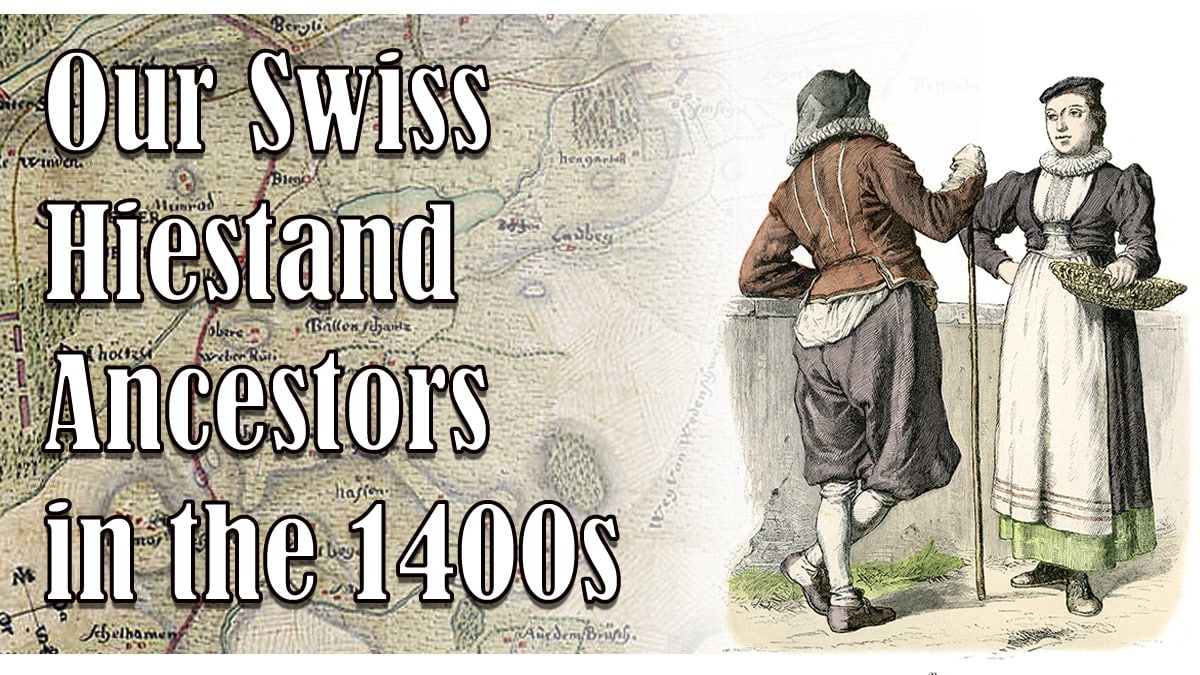Our Swiss Hiestand Ancestors in the 1400s

Dr. Peter Ziegler (Zürich, Switzerland) and Dr. Wayne Haston (Pennsylvania, USA), Co-Authors
(Including significant research data from Kent Douglas Hiestand)
"Early Swiss Hiestands" Series
German Version of this Article
Nearly 100 years before 1492–when “Columbus sailed the ocean blue”–we had Hiestand ancestors in Canton Zürich, Switzerland who were clearing forests, farming on the beautiful mountain slopes south of Lake Zürich, building houses and barns that lasted 100s of years, fishing in the Bibetsee (now, Hüttenersee), and attending church and worshiping God. Some of their names are known, as well as where they lived. And in some cases, we know a little bit about them–the kind of people they were and some of their land transactions.
Around 1500 AD, the Hiestand family spread down the mountainside towards the villages of Wädenswil and Richterswil. The yellow dots indicate properties that we know were farmed by Hiestands in the 15th century. Most of the Hiestand farms were located on one of the pilgrimage routes that led through the rule of the Johanniter to the famous Catholic Benedictine monastery in Einsiedeln. Only the Schönau was remote and could therefore become a “Nest of the Anabaptists” in the 16th and 17th centuries. The most important pilgrimage route led from Horgner Berg via Beichlen – Tanne – Egg – Fälmis – Blegi and Lölismühle towards Schindellegi. There Catholic pilgrims crossed the Sihl and, ascending through the foothills of the Alps, reached the abbey “Our Lady of Einsiedeln” via Bennau and Schnabelsberg.

See if you can find “Fälmis“ on this map–look at the yellow place names. In 1401, Heini Hiestand may have lived there or very near there. He’s the first person we know of who was named “Hiestand.” But obviously, we had pre-Hiestand-named ancestors living there before Heini appeared on a tax list with the Hiestand surname. Family names were just beginning to be used at that time.
See if you can find “Beichlen“ and “Himmeri“ on the map. In another article, I’ll tell you about Ueli Hiestand and his connection to these two farms. Apparently, from the existing records (about 12 of them) that mention him, he must have been an outstanding citizen in his day. I’ve dedicated an entire article to Ueli Hiestand.
Do you see Schönau? It’s an interesting little place, where some of our ancestors lived. It became a “nest of Anabaptists” in the 1600s. More about that in a later article.
And look for the village of Hütten. Some of our Swiss relatives played some important roles in building a chapel there in 1496.
Note: It was converted into a Protestant chapel in the course of the Reformation around 1600.
Some Early Swiss Hiestands According to Authors Schobinger, Egli, and Kläus
These authors mentioned a Claus Hiestand who lived in the village of Feusisberg of Canton Schwyz. Feusisberg was approximately two and a half miles (4.5 kilometers) southeast of Richterswil. But we have not been able to find any original documents to confirm the location of a Claus Hiestand there at that time.

English translation: Hiestand «Hieschtand» ♣ Hütten, Richterswil, Schönenberg, Wädenswil ♦ Heini Hiestand 1401 Wädenwil area – Claus Hiestand 1401 Wollerau/Feuisberg SZ – Ulin Hiestand / Rudi Hiestand 1432 Richterswil – Uli Hiestand am Wädenswiler Berg receives the farm in 1448 Bennkli (Beichlen) to fiefdom – Claus Hiestand (and) sin wib 1455 huts – Uely Hiestand (and) sin wip 1455 Waedenswilerberg. ♠ Set name, mhd. hie constant! «it says here!», request to a restless person.
mhd = Middle High German
The 1496 Chapel at Hütten
As you can see on the map above, many of the 15th Century Hiestands lived high on the mountain slopes above Wädenswil and Richterswil, closer to Hütten than to the lakeshore villages. In order to attend church, the “mountain Hiestands” had to go down the steep slope to one of the lakeshore village churches, then make the difficult uphill journey back home later the same day.
Year in and year out, people [Hüttners] went down to Lake Zurich on a long and often arduous journey Sunday after Sunday. They brought their children to Richterswil for baptism and the dead to their final resting place. In winter, going to church to Richterswil was particularly difficult. “Whatever the weather, the Hüttener make the two-hour walk to the Richterswil church, pale and blue, shivering and when they have frozen enough they have to have to go back hungry the same long and arduous way, and it is often late in the evening."
The construction of a separate chapel in Hütten was intended to provide relief in 1496. There were enough families in Hütten at that time who supported this idea. The construction was made possible thanks to donations of money and the services of honorable pious Christians, including several Hiestands.
Kapelle-Rodel Hütten, 1496 Document - Consecration of the Chapel and Donors to the Project
Some excerpts from the 1496 document:

In the year counted one thousand four hundred and ninety-six [1496] years after the birth of Christ, this chapel “to the huts [Hütten]” was consecrated.
The St. John’s priests shall first sing a mass for the consolation of souls and as a help for all deceased people.
Afterwards, a Mass shall be sung in honor of Mary, the Mother of God, for the consolation and intercession of all living benefactors, who shall continue to do good and may therefore believe that Almighty God may grant them a blessed life here in this world and eternal life after this life.
The other priests are to say Mass at the side altars, also in memory of the living and the dead.
The relics of the patron saints of this church have been placed in the altar.
The main altar in the choir is consecrated in honor of St. James (St. James), the church patron, as well as John the Baptist and the Ten Thousand Knights.
Some Hütten-area Hiestands made
significant contributions to the chapel construction:
Ruedi Hiestand, called Tusam (“the oppressed one”), and Elsi Höfliger, the wife of Ueli Wymann, who laid the foundation stone for the chapel, were Gotte and Gotti, and both have already donated twenty pounds of Haller [coined in Halle] to this construction.
Note: It was an honor that they were chosen as godfather and godmother for this project. It was also a thank you for donating twenty pounds of Haller (money minted in Halle) to the construction of the chapel, which was probably the highest amount.
Hans Hiestand gave ten shillings, encumbering the estate zu den Berghüseren (Bergli), his residence.
Ruotsch Hiestand from the Lölismühle [today Neumühle, Wollerau] sawed all the wooden shutters free of charge as a contribution to the Jahrzeit.
In addition, Hans Hiestand junior gave ten shillings for himself and Anna Hiestand and for all deceased members of the Hiestand family.
Keep in mind - all of the above happened in the 1400s A.D.
The Hütten chapel was built for the Catholics, but in 1604, as a belated consequence of the Reformation,
it was converted into a Reformed church.
In1519 the Reformation began in the city of Zurich. In 1523, the pastor of Richterswil, Gregor Lüthi, professed the Reformation of Huldrych Zwingli. Six years later, the majority of the church members followed his decision. On May 12, Hans Wirz, the administrator of the Johanniterkomturei Wädenswil, and Heinrich Eschmann appeared as deputies of the Richterswilers before the mayor and council of the city of Zurich. They reported that the church members had decided in a community meeting to convert to the new, Reformed faith. In Richterswil, the saints and images had already been removed. The St. Jacob’s Chapel in Hütten was still used by both denominations and the three altars were still standing until 1604, but covered. Then they were torn down. A pulpit was built and the kneeling benches were replaced by pews. This late reformation in Hütten can be explained by the chapel, which was built only 20 years before the reformation. Many descendants still commemorated their deceased ancestors, donors and front workers every year.
This chapel was destroyed by Catholics during the First Villmerger War (1656).
If you appreciated this article, please share it with others who might also enjoy it.


Have Mennonite or Amish Roots? – Participate in this DNA Research Project

